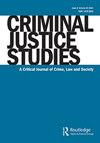Hostility and reactive criminal thinking as mediators of the violent victimization–violent offending relationship: affect before cognition?
IF 1.1
Q3 OPERATIONS RESEARCH & MANAGEMENT SCIENCE
引用次数: 9
Abstract
ABSTRACT The purpose of this study was two-fold: 1. determine whether an affective-cognitive construct, hostility, and a cognitive-affective criminal thinking style, reactive criminal thinking (RCT), mediate the relationship between prior violent victimization and future violent offending, and 2. ascertain whether mediator order – hostility before RCT and RCT before hostility – makes a difference in the overall results. Using seven waves of data, three overlapping analyses were performed on data provided by 1,354 youth (1,170 males, 184 females; mean age = 16.04 years) from the Pathways to Desistance study. A two-mediator pathway that placed hostility before RCT (Victimization-1/2/3 → Hostility-2/3/4 → RCT-3/4/5 → Offending-4/5/6) proved significant in all three analyses, whereas the alternate two-mediator pathway, in which the order of the two mediators was reversed (i.e. RCT-2/3/4 → Hostility-3/4/5), was non-significant in two out of the three analyses. Five single-mediator pathways, four of which were mediated by hostility, were also significant. Congruent with aspects of both general strain and criminal lifestyle theories, violent victimization appeared to stimulate short-term situational hostility, which, in turn, facilitated or primed formation of reactive criminal thinking and the youth’s eventual participation in criminal violence, although hostility alone had a significant impact on criminal violence as well.敌意和反应性犯罪思维在暴力受害-暴力犯罪关系中的中介作用:认知前的影响?
摘要:本研究的目的有两个方面:1。2.确定情感-认知构念、敌意和认知-情感犯罪思维方式、反应性犯罪思维(RCT)是否在先前暴力受害与未来暴力犯罪之间起中介作用;确定中介顺序——敌意前的RCT和敌意前的RCT——是否对整体结果有影响。使用7波数据,对1354名青年(1170名男性,184名女性;平均年龄= 16.04岁)。将敌意置于RCT之前的双中介路径(受害-1/2/3→敌意-2/3/4→RCT-3/4/5→冒犯-4/5/6)在所有三个分析中都证明了显著性,而交替的双中介路径,即两个中介的顺序颠倒(即RCT-2/3/4→敌意-3/4/5),在三个分析中的两个中都不显著。五个单一中介通路,其中四个由敌意介导,也具有显著性。与一般压力理论和犯罪生活方式理论相一致的是,暴力受害似乎会刺激短期的情境敌意,这反过来又促进或启动反应性犯罪思维的形成,并最终导致青少年参与犯罪暴力,尽管敌意本身对犯罪暴力也有重大影响。
本文章由计算机程序翻译,如有差异,请以英文原文为准。
求助全文
约1分钟内获得全文
求助全文
来源期刊

CRIMINAL JUSTICE STUDIES
OPERATIONS RESEARCH & MANAGEMENT SCIENCE-
CiteScore
2.80
自引率
5.60%
发文量
17
期刊介绍:
Criminal Justice Studies, a quarterly refereed journal, publishes articles that deal with substantive criminal justice and criminological issues. The journal welcomes all articles that are relevant to the issue of criminal justice, as well as those that may be outside the field but have relevancy to the topic of criminal justice. Articles that cover public administration, issues of public policy, as well as public affairs issues are welcome. The journal also publishes relevant literature reviews, research notes and summary reports of innovative research projects in criminal justice. Qualitative and quantifiable articles are sought mainly from academics and researchers in the field, though articles from professionals will also be considered.
 求助内容:
求助内容: 应助结果提醒方式:
应助结果提醒方式:


